
If you are from the traditional Contact Centre technology world and have witnessed implementations you will know how painful and expensive the process can be with technology vendors pushing premises-based infrastructure based solutions requiring large capex investments. They will first spend weeks developing requirements, have another month lead time for infrastructure (if you’re lucky) and then have engineers rock up and build complex black box solutions that only they understand. Once this is all done and delivered they have you locked in with a nice maintenance and support contract for the next 3-5 years.
What if you didn’t need upfront capex investments, and had a solution and partner that could give you a working prototype solution within a day. Then had it ready for you to adapt to your business for complex use cases with a few more days collaborative discussions. Sounds more appealing, right? The cherry on the cake is you only pay for what you use on an opex basis. What would typically cost £50,000-£100,000 to merely get the first call through traditional CC software, now costs less than £50 with Amazon Connect to have a fully operational contact centre ready for you to prototype and adapt to your business. My first Proof of Concept cost $1.57 to build and run for 48 hours with test calls.
Sounds too easy and too good to believe! Is it really? I hear you say. Let’s look at how easy.
Commercials
Amazon remove the first blocker by giving you a free-tier account for a year to prototype your contact centre. All you pay for is the calls you make. That means no upfront infrastructure costs. However, you will need to register a credit card to pay for what you use outside the free tier. Amazon clearly label what is part of the free tier and what is not and provide you with a capability to setup billing alerts to your email or mobile for any breaches of thresholds you setup. So you are always in control of what you are going to be charged.
Amazon provides a Total Cost of Ownership (TCO) calculator to help you forecast your future costs which is easy to use and provides the perfect information to submit your business case.
International reach but local cost models
The first thing you need to do is decide where in the world your Contact Centre instance is to be hosted. Amazon use the term instance to describe your contact centre entity which must reside in a region e.g. USA- Virginia, London, Frankfurt.., you get the idea. The natural thing to assume at this stage is pick the one closest to you to optimise performance by mitigating latency risks, but this would be wrong because if you are going to use advanced features such as Lex you have to decide whether the functionality you require is available in your region. Lex, the Amazon Natural Language recognition service is currently only available in U.S.A (Virginia), but it is getting rolled out to other regions as we speak. If you are not using these features then pick something locally. As my use cases require Lex I chose U.S.A Virginia.
You are probably wondering, will that effect the cost of my outbound calls and the cost of calls from my customers to my contact centre? Rest assured Amazon have thought this through. When you choose the region (location) for your instance, Amazon ask you to claim phone numbers to associate to your contact centre and these can be anywhere in the world, in my case I chose London numbers because my callers and I are in London. Which means for my U.K customers all inbound and outbound calls are now billed as local calls.
Contact Centre Resources
Amazon Connect has 2 simple methods of defining Contact centre resources either individually enter each agent using the AWS Console as per the image below:
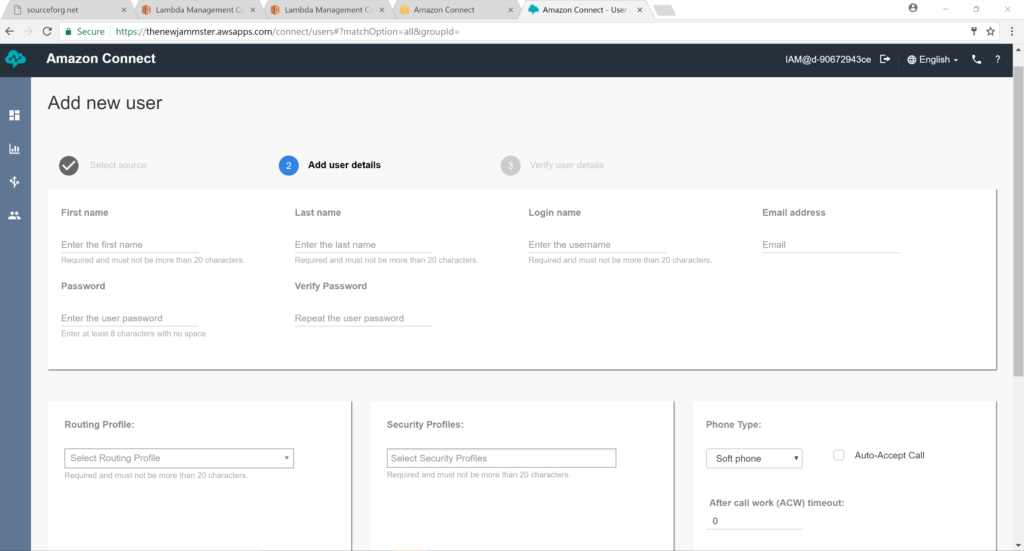
Or do a bulk upload using a .CSV file.
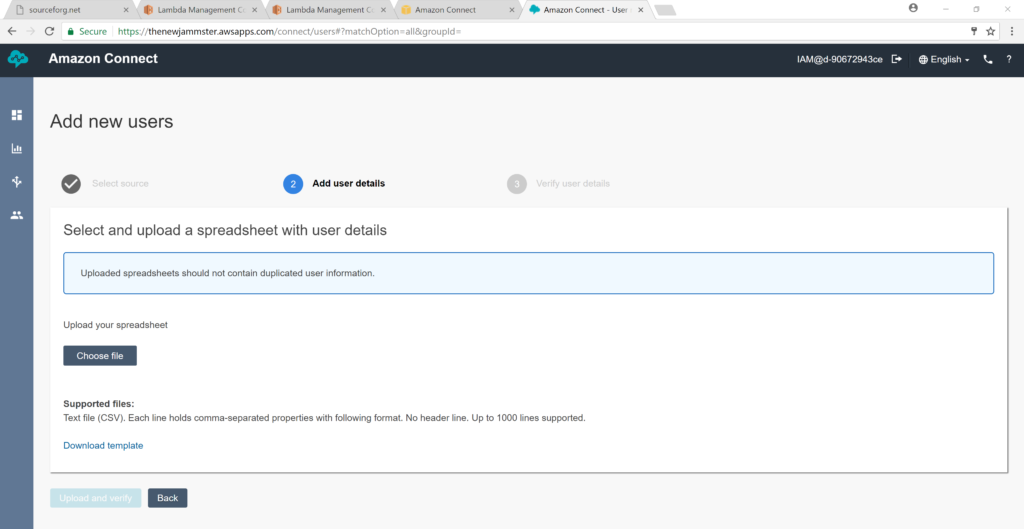
Couldn’t be simpler! Hands up to those that have Contact Centre Solutions and been dependent on external consultants for a bulk upload of users? You don’t have that problem with Amazon Connect, it gives back control of the contact centre to the business.
Setting Up Queues
Every Contact Centre requires queues for a) callers to be directed to and b) agents to be associated with to receive calls. The former is straight forward using the Queue form, where each queue is defined along with its key attributes:
- Hours of operations
- Maximum queue length
- Outbound Queue id – this will be the telephone number (DNIS) that your customers will call for this Queue. This is important as you may have different numbers for different services or parts of the organisation.
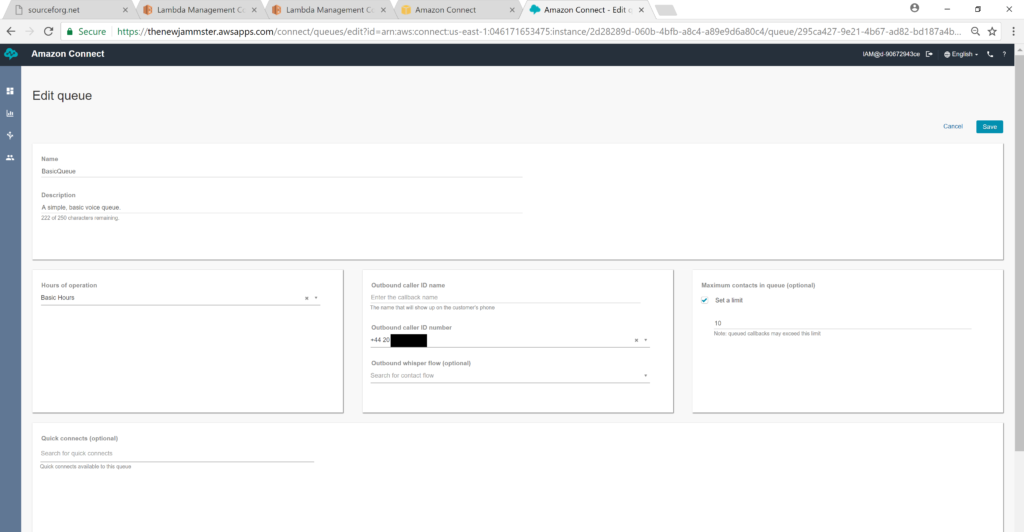
Let’s look at b) above, Amazon is unique when associating agents with queues. They have solved the problem, where in Contact Centres the number of callers doesn’t match the Workforce Management forecasting that you have used to do resourcing, resulting in Contact centre administrators and supervisors frantically moving agents into and out of queues or target routing groups. They do this by allocating agents to routing profiles.
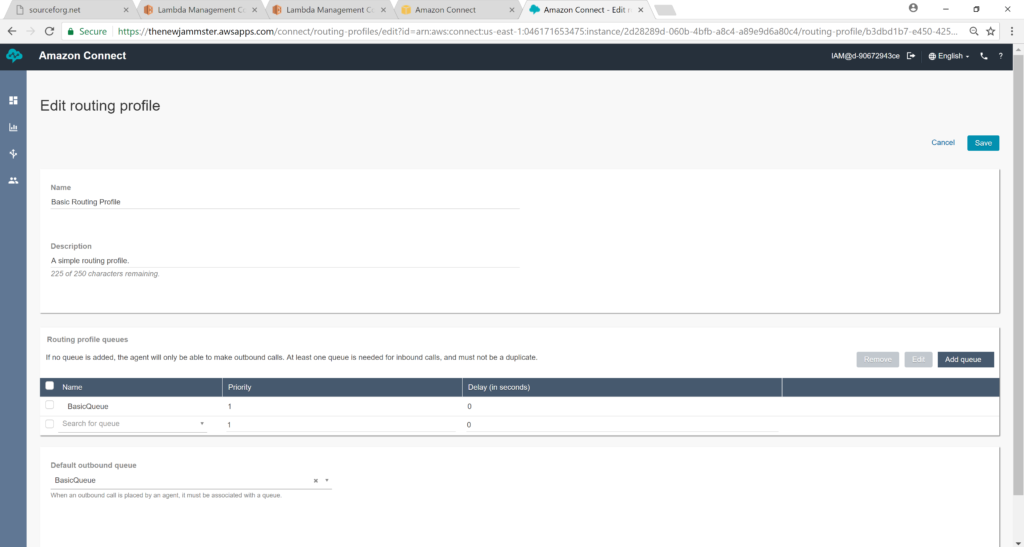
Each routing profile can be associated with multiple queues and each queue has a weighting of how many seconds the customer was queuing before the agent associated with that queue would be available to receive a call. Now the Contact Centre agents can be targeted more naturally based on demand without operational intervention. This will allow you to use the most skilled resources for complex transactions and when demand is high and affecting customer experience in other queues these high value agents can be pulled in automatically to deal with the spike in demand. When demand returns back to normal these high value agents then continue to receive the more complex or high value calls. We will discuss routing profiles in more detail in another blog.
Call Flow Design
Amazon connect provides a very powerful GUI based call flow editor which enables you to develop complex call flows in literally minutes. Below is a sample call flow in development which shows how intuitive the drag and drop interface is:
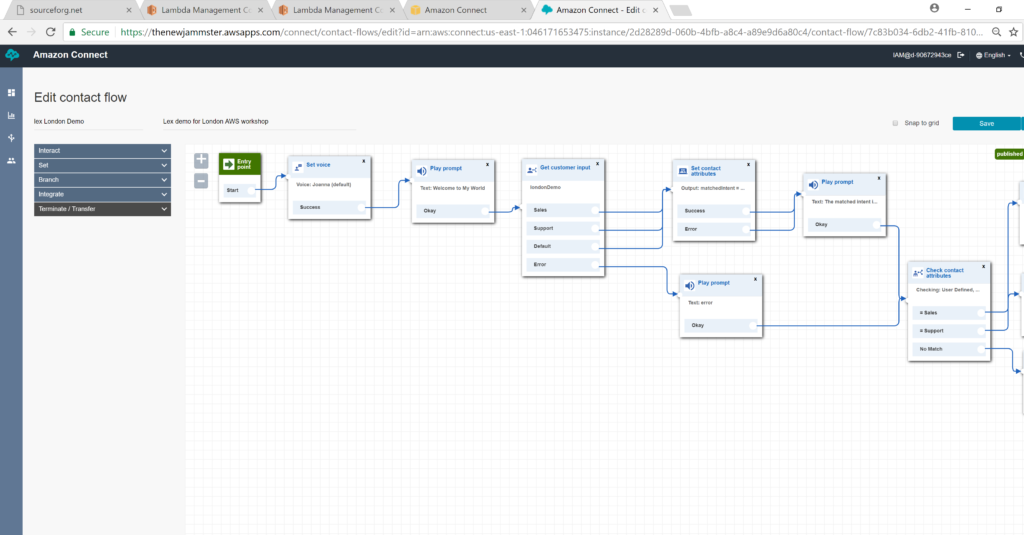
The GUI Call Flow editor has functions in five key categories which the user drags, drops and configures:
- Branch – Branch functions allow you to make decisions on how to deal with the caller based on queue status, staffing availability, your operational hours, data associated with the caller and percentage distribution to targets.
- Integrate – The Interact function is probably the most powerful function as it allows you to write bespoke code written in any of the following languages: Node.js (JavaScript), Python, Java (Java 8 compatible), and C# (.NET Core). These functions can be invoked from anywhere within your Call Flow. So if you have some fancy algorithms or even a simple database dip, this is the place to do it. We will explore these in much more detail in future blogs when we walk through Lambda functions in our sample Use Cases.
- Interact – Where integrate was the most powerful, the Interact function is probably the most sexy in that it exposes Amazon’s natural language processing capability (Lex) in a simple easy to use way that makes it accessible to anybody to use. No more having specialists develop Nuance modules in your contact centre. All you have to do is define phrases, their intents and associate them to each other. Lex will learn and do the rest, so when there is not an exact match it is smart enough to understand the intent and will route accordingly. As for the traditional things like voice prompts and IVR DTMF input – yes it does that too and it’s just a simple completion of a few fields, clickety click and you’re on your way.
- Set – The set function is the equivalent of assigning a variable a value where these can be contact attributes, changing the voice used for voice prompts or assigning the target queue for this caller.
- Transfer – The transfer function determines what is the final action for the caller, i.e. where to transfer them e.g. queue, another call flow or phone number; disconnect or hang-up the caller.
Below are the full set of currently available functions available in the Call flow editor, but bear in mind this list is growing on a weekly basis due to Amazon’s prolific speed of development, so by the time you play with it don’t be surprised if there is even more rich functionality available.
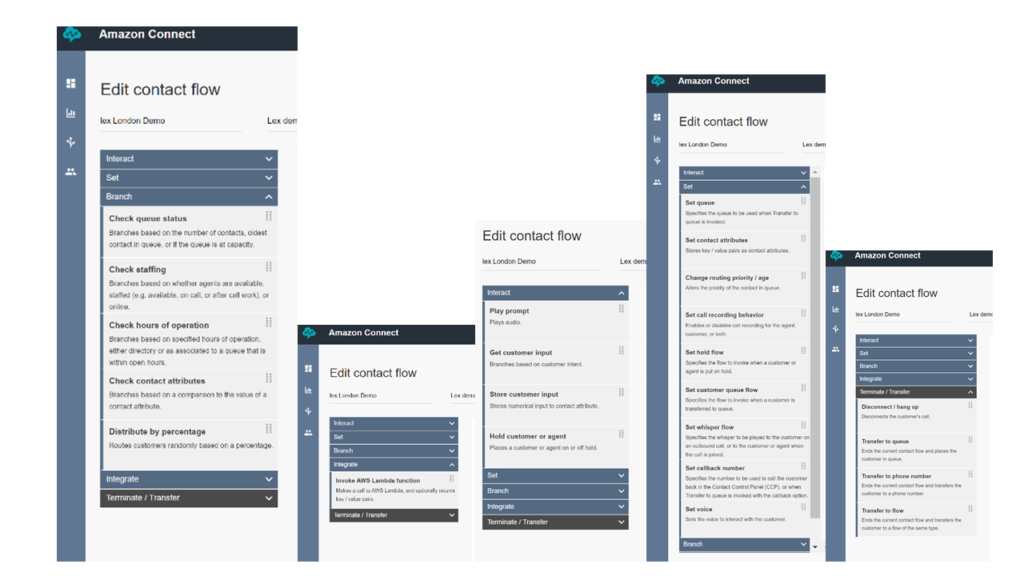
The softphone
Finally, Amazon Connect provides a simple but powerful softphone. On the face of it looks simple, allows you to set your status, dial a number and look for other resources in your contact centre. But the real power is the fact that you can embed this softphone into your own website or intranet in a HTML wrapper. Thereby allowing you to write java / JavaScript code to deliver a much more refined bespoke set of functionality e.g. Customer records, buttons with business specific functionality and whatever else the agent requires to deliver that optimum customer experience.
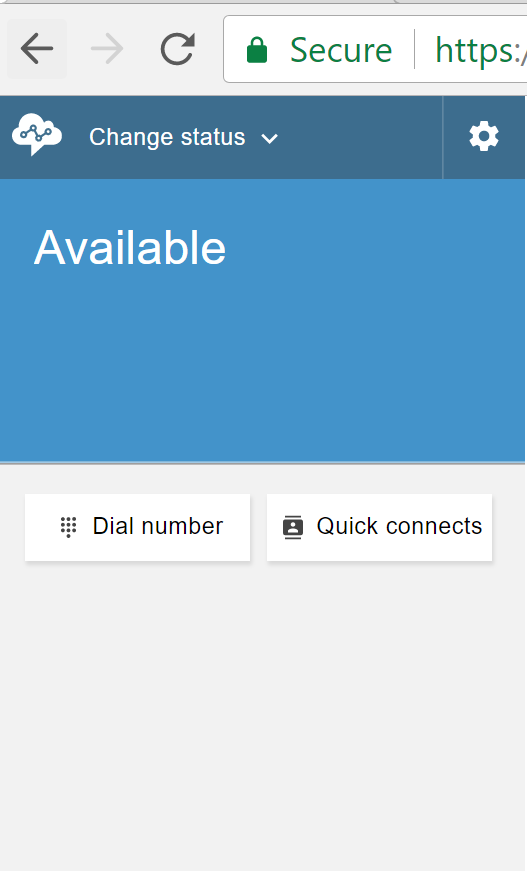
A few use cases we knocked up
So how easy is it to create use cases and how long would it take to do them? Below is a set of Use cases that our consultants have put together as Proof of Concepts as starting points for discussion with our customers. These examples assume the name of the caller is Joe Bloggs. Each of these took no more than a day to implement. So businesses really can use the agile approach to get their proof of concepts right by refining them with a small group of agents before rolling out the technology to the wider business. No more of the big bang approach!
Use Case 1 – CRM dip and suggestion
- Joe Bloggs calls in to Contact Centre
- CRM dip identifies Joe Bloggs from Dynamics CRM (or table in Excel/MSQL)
- Identifies that Joe Bloggs is a Customer that made an order for a mobile
- Suggest why they are calling i.e. re order and date of order or is it something else ?
- Customer speaks and sates either yes or says no and mentions what e.g. broadband enquiry
- Say “thank you”, and customer routed to correct Queue and data (CLI, Name, Reason) passed to agent for screen pop
Use Case 2 – IVR options and routing
- Joe Bloggs calls in to Contact Centre
- Caller hears Music and put on hold for 10 seconds
- State routing options
- 1 – Sales
- 2 – Billing
- 3 – Support
- 4 Anything else
- Caller states option (verbally or typing – DTMF) e.g. Billing
- Route call to queue but no agent available, play Music on hold, state position in queue every 30 seconds
- Agent becomes available and gets calls from Joe Bloggs, agent needs to escalate call to Support but needs to do a 3-way conference with Billing agent and customer.
- Agent conferences in their supervisor onto the call.
Use Case 3 – Web chat initiating an outbound call
- Joe Bloggs is browsing the website and is prompted for assistance after clicking on a service AND has already been idle for 20 seconds before clicking.
- Browser prompted for assistance via chat or a call back.
- Joe selected chat and initiates chat session. NB as a follow up audit for customer all Chat transcripts sent as email to customer at end of chat session.
- During chat session Joe B. types “call me”.
- On typing Call me – Chat asks number to be called (but suggests number from customer record using Database lookup)
- Customer call back initiated.
Intrigued enough and want to know more?
If you want to play with Amazon Connect visit the Amazon Connect web site to claim your 1 year free-tier subscription at: https://aws.amazon.com/free/ . However, if you want some help to put together a Proof of Concept to see what Amazon Connect can do for you, give us a call on +44 7956949622 or email us directly on ja@jammster.com alternatively email info@jammster.com .